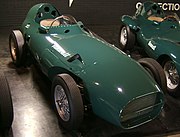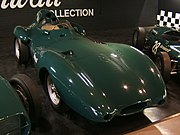
John Michael Hawthorn was a British racing driver, who competed in Formula One from 1952 to 1958. Hawthorn won the Formula One World Drivers' Championship in 1958 with Ferrari, and won three Grands Prix across seven seasons. In endurance racing, Hawthorn won both the 24 Hours of Le Mans and the 12 Hours of Sebring in 1955 with Jaguar.
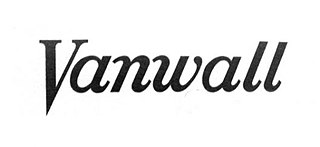
Vanwall was a British motor racing team and racing car constructor that was active in Formula One during the 1950s. Founded by Tony Vandervell, the Vanwall name was derived by combining the name of the team owner with that of his Thinwall bearings produced at the Vandervell Products factory at Acton, London. Originally entering modified Ferraris in non-championship races, Vanwall constructed their first cars to race in the 1954 Formula One season. The team achieved their first race win in the 1957 British Grand Prix, with Stirling Moss and Tony Brooks sharing a VW 5, earning the team the distinction of constructing the first British-built car to win a World Championship race. Vanwall won the inaugural Constructors' Championship in Formula One in 1958, in the process allowing Moss and Brooks to finish second and third in the Drivers' Championship standings, each winning three races for Vanwall. Vandervell's failing health meant 1958 would be the last full season; the squad ran cars in a handful of races in the following years, but finished racing in 1961.

The 1955 Belgian Grand Prix was a Formula One motor race held at Spa-Francorchamps on June 5, 1955. It was race 4 of 7 in the 1955 World Championship of Drivers. The 36-lap race was won by Mercedes driver Juan Manuel Fangio after he started from second position. His teammate Stirling Moss finished second and Ferrari driver Nino Farina came in third.

The 1958 Argentine Grand Prix was a Formula One motor race held on 19 January 1958 at Autodromo Municipal Ciudad de Buenos Aires Circuit. It was race 1 of 11 in the 1958 World Championship of Drivers and race 1 of 10 in the 1958 International Cup for Formula One Manufacturers. The race was the sixth Argentine Grand Prix. It was held on the #2 variation of the circuit. The race was held over 80 laps of the four kilometre circuit for a total race distance of 313 kilometres.

The 1958 Monaco Grand Prix was a Formula One motor race held on 18 May 1958 at Monaco. It was race 2 of 11 in the 1958 World Championship of Drivers and race 2 of 10 in the 1958 International Cup for Formula One Manufacturers. The race was the 16th Monaco Grand Prix and was held over 100 laps of the three kilometre circuit for a total race distance of 314 kilometres.

The 1958 Belgian Grand Prix was a Formula One motor race held on 15 June 1958 at Spa-Francorchamps. It was race 5 of 11 in the 1958 World Championship of Drivers and race 4 of 10 in the 1958 International Cup for Formula One Manufacturers. The race was the 19th Belgian Grand Prix and it was held over 24 laps of the 14 kilometre circuit for a race distance of 339 kilometres.
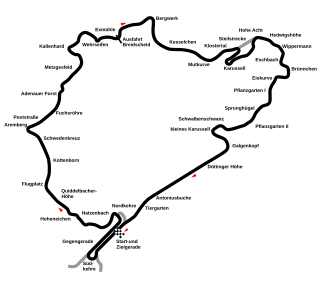
The 1958 German Grand Prix was a Formula One race held on 3 August 1958 at Nürburgring. It was race 8 of 11 in the 1958 World Championship of Drivers and race 7 of 10 in the 1958 International Cup for Formula One Manufacturers.

The 1958 Italian Grand Prix was a Formula One motor race held at Monza on 7 September 1958. It was race 10 of 11 in the 1958 World Championship of Drivers and race 9 of 10 in the 1958 International Cup for Formula One Manufacturers. Vanwall won the first Constructors' Championship in the category with 1 race left to go. After retiring his original car, entered by Scuderia Centro Sud, Carroll Shelby took over Masten Gregory's car, entered by Temple Buell, and finished fourth. No points were awarded for the shared drive.

Harry Lawrence O'Reilly Schell was an American racing driver, who competed in Formula One from 1950 to 1960.

Peter John Collins was a British racing driver, who competed in Formula One from 1952 to 1958. Collins won three Formula One Grands Prix across seven seasons. In endurance racing, Collins won the 12 Hours of Sebring in 1958 with Ferrari.
Stuart Nigel Lewis-Evans was a British racing driver from England. He participated in 14 Formula One World Championship Grands Prix, debuting on 19 May 1957. He achieved two podiums, and scored a total of 16 championship points. He also achieved two pole positions.

The 1958 Moroccan Grand Prix, formally the VII Grand Prix International Automobile du Maroc, was a one-off Formula One motor race held at Ain-Diab Circuit, Casablanca on 19 October 1958, after a six-week break following the Italian Grand Prix. It was race 11 of 11 in the 1958 World Championship of Drivers and race 10 of 10 in the 1958 International Cup for Formula One Manufacturers. It is the only time Morocco has hosted a World Championship Grand Prix.

The Simca-Gordini Type 15, also known simply as the Gordini Type 15, is an open-wheel race car, designed, developed, and built by French manufacturer Gordini, to compete in Formula One, and was produced between 1947 and 1953.
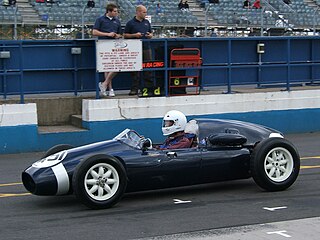
The Cooper T45 was an open-wheel formula racing car, developed and built by the Cooper Car Company in 1958, and designed by Owen Maddock. It competed in Formula 2 racing as well as in Formula One racing, where it won one World Championship Grand Prix, the 1958 Monaco Grand Prix, being driven by Maurice Trintignant.

The Cooper-Bristol, formally called the Cooper Mk.I or the Cooper T20, is a Formula 2 racing car, built, designed, and developed by British manufacturer Cooper Cars in 1952.
The BRM 4-cylinder engines are a series of four-stroke, naturally-aspirated, 2.5 L (150 cu in), inline-four Formula One racing engines, designed, developed and built by British Racing Motors, between 1956 and 1960. They were exclusively used by BRM; and powered the BRM team cars. It was constructed to conform the FIA engine requirements; necessitating a 2.5 L naturally-aspirated engine displacement formula. The power output for these motors were between 260–285 hp (194–213 kW), and 205 lb⋅ft (278 N⋅m).

The Brabham BT17 was a one-off sports prototype race car, designed by British-Australian engineer Ron Tauranac, and developed and built by British manufacturer, constructor, and Formula One racing team, Brabham. It was built to Group 7 racing specifications, in 1966, and was the only Group 7 sports car built by Brabham. Only one single model was produced. It only contested three sports car races, scoring no wins, podiums, pole positions, or points finishes.
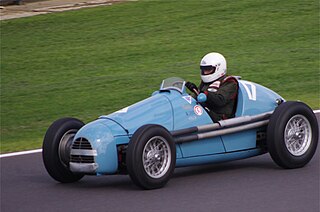
The Gordini T16, also known as Gordini Type 16 is an open-wheel race car, designed, developed and built by French manufacturer Gordini, for Formula One and Formula Two racing categories, between 1952 and 1956.
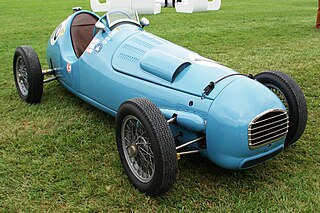
The Simca-Gordini T11, also known simply as the Gordini Type 11, is an open-wheel race car, designed, developed, and built by French manufacturer Gordini, to compete in Formula One, and was produced between 1946 and 1953.

The Gordini T32 was an open-wheel formula racing car, designed, developed and built by French manufacturer Gordini, for the 1955 and 1957 Formula One World Championship seasons.


